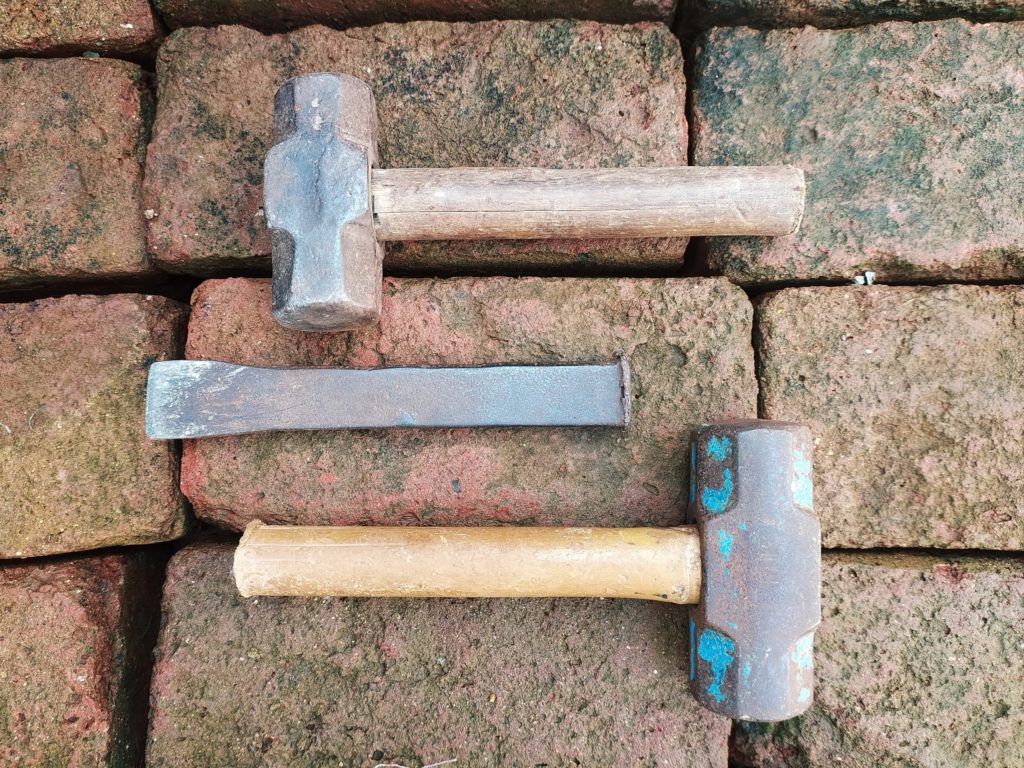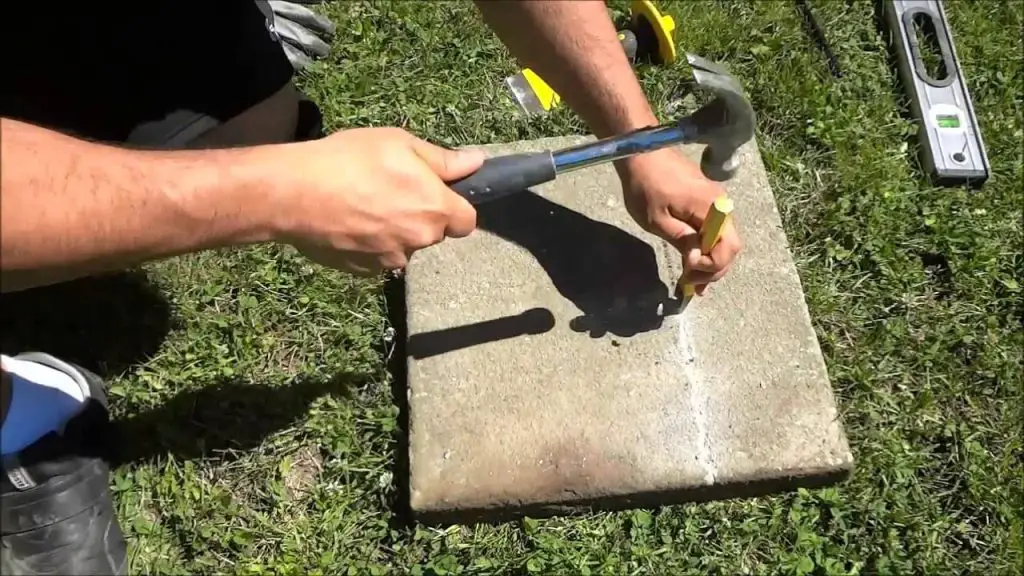How Do You Cut Pavers Without A Saw? Pavers are a type of stone or brick that is often used to create patios, walkways, and other types of outdoor areas. While pavers are relatively easy to install, they can be difficult to cut without the proper tools. If you need to cut pavers but don’t have a saw, there are a few different methods you can use.
If you’re looking to do a little home improvement on your own, you may be wondering how to cut pavers without a saw. After all, saws can be expensive and they’re not always necessary for every project. Luckily, there are a few different ways that you can go about cutting pavers without having to use a saw.
Cutting Pavers without Saw
One method is to use a chisel and hammer. Simply place the chisel where you want to make your cut and then hit it with the hammer until it goes through the paver. This method does take a little bit of time and effort, but it’s definitely doable if you don’t have access to a saw.
Another option is to use an angle grinder fitted with a masonry blade. This will make quick work of cutting through pavers and is really easy to do. Just be sure to wear safety goggles and gloves when using this method as the blades can get quite hot during operation.
Finally, if you have access to an electric drill, you can actually drill through the paver in order to make your cuts. This is probably the quickest and easiest way to go about it, but again, be sure that you’re wearing safety gear while doing this. So there you have it – three different ways that you can cut pavers without having to use a saw.
Give one of these methods a try next time you need to tackle this type of home improvement project!

Credit: sspavers.com
How Do You Cut a Paver Without a Saw?
If you need to cut a paver but don’t have a saw on hand, there are a few different ways you can do it. Depending on the size and thickness of the paver, you may be able to use a hammer and chisel to break it apart. If the paper is too thick for this method, you can try scoring it with a utility knife or masonry bit before breaking it apart.
You can also use a power drill with a masonry blade attachment to make clean cuts through the paver. Whichever method you choose, always wear safety goggles and gloves to protect yourself from flying debris.
How Do You Cut Pavers Without Power Tools?
If you’re working with pavers that are made of a softer material, like brick or stone, you can use a hand saw or masonry blade to cut through them. For tougher materials, like concrete, you’ll need to use a power saw with a diamond blade. Here’s a step-by-step guide to cutting pavers without power tools:
1. Mark the area where you need to make your cut. Use a chalk line or marker to draw a straight line on the paver.
2. Score the paver along the marked line using a masonry blade or carbide-tipped pencil. Apply even pressure as you drag the blade or pencil across the surface of the paper.
3. Place one end of the paver on a block of wood and gently tap it with a mallet until it breaks along the scored line. Repeat this process for any remaining pieces that need to be cut.
What is the Best Tool to Cut Pavers?
If you’re looking to do some paving work around your home, you might be wondering what the best tool is to cut pavers. There are a few different options available, and the best one for you will depend on the type of pavers you’re using and the size of the job. For small jobs or projects where precision is key, a handheld power saw like a jigsaw or reciprocating saw will do the trick.
Just make sure to use a blade that’s designed for cutting masonry or concrete. If you’re working with larger pavers, you may need a heavier-duty power saw as a circular saw or brick saw. Again, be sure to choose a blade that’s appropriate for cutting masonry materials.
If you don’t have access to power tools, or if you prefer not to use them, you can also cut pavers with a cold chisel and hammer. This method takes more time and effort than using power tools, but it’s perfectly viable if that’s what you have available. Just remember to wear safety goggles and gloves to protect yourself from flying chips of stone.
No matter which method you choose, take your time and make sure your cuts are straight and even. Uneven cuts can ruin the look of an otherwise perfect paving job!
6 Ways to Cut a Paving Stone
How to Cut Pavers by Hand
There are a variety of ways to cut pavers by hand, and the best method will vary depending on the type and thickness of the paver you are working with. For thinner pavers, a simple handheld power saw or even a sharp utility knife can be used to make clean, straight cuts. If you are working with thicker pavers, however, you will need to use a more heavy-duty saw such as a masonry blade attached to a circular saw.
Whichever tools you use, be sure to wear safety goggles and gloves to protect yourself from flying debris. When cutting pavers by hand, it is important to take your time and make sure that your cuts are straight and even. This can be accomplished by first marking out your cut line with chalk or pencil before making any cuts.
For larger projects, it may also be helpful to set up a guideboard along your cut line to help keep your cuts straight. When using power tools, always follow the manufacturer’s instructions carefully and never force the tool through the paver – let the blade do the work for you. With patience and practice, cutting pavers by hand can be easy and rewarding!
How to Cut Pavers for Curves
If you’re looking to add a little something extra to your outdoor space, consider adding some curves! Curves can add interest and dimension to any landscape, and they’re not as difficult to create as you might think. With just a few tools and a little bit of know-how, you can easily cut pavers for curves in your own backyard.
The first thing you’ll need is a saw. A standard hand saw or power saw will work fine, but for best results, we recommend using a wet saw with a diamond blade. This type of saw will make clean cuts and help prevent the pavers from chipping or cracking.
Once you have your saw, mark out the area where you want your curve to be. Then, starting at one end of the curve slowly and carefully cut along the line with your saw. Make sure to keep the blade wet throughout the process to avoid damaging the pavers.
As you get closer to the other end of the curve, you may need to adjust your cutting angle slightly so that all of the pavers fit nicely together. Once everything looks good, go ahead and give your newly created curve a try!
How to Cut Pavers With Angle Grinder
Angle grinders are versatile tools that can be used for a variety of projects, including cutting pavers. When cutting pavers with an angle grinder, it’s important to use the right type of blade and take precautions to avoid damage to the pavers. Here’s a step-by-step guide to cutting pavers with an angle grinder:
1. Select the right blade for your angle grinder. If you’re using a standard 4-1/2″ angle grinder, you’ll need a diamond blade that is compatible with that size. For other sizes of angle grinders, consult your user manual to determine the appropriate size of the diamond blade.
2. Attach the diamond blade to your angle grinder according to the manufacturer’s instructions. Make sure that the blade is securely in place before proceeding.
3. Put on safety goggles and gloves before starting your project. Angle grinders can create dust and debris that can be harmful if inhaled or if it comes into contact with your skin.
4. Mark the area where you will be cutting the paver with chalk or tape so you have a straight line to follow. Place the paver on a stable surface such as a work table or saw horse before beginning to cut.
5 . Holding the paver firmly in place, start the angle grinder and slowly guide it along the marked line on the paver. Apply gentle pressureto keepthe blade moving forward; don’t try to force it through too quickly or you may crack or chip the paver.
Be especially careful when making curves or turns; go slowly and steady your hands to avoid veering off course.
6 . Once you’ve reached the end of the line, stop the angle grinder and let it cool before removing the diamond blade according to your manufacturer’s instructions
7. Use a wire brush or other abrasive tool to clean off any excess mortar or paver splinters from around the edge of your newly cut pavers
8 . Admire your handiwork!
How to Cut 2 Inch Concrete Pavers
Assuming you are using a standard 2″ thick paver, the following instructions will help you cut them to size. You will need:
-A saw capable of cutting concrete pavers.
A wet saw with a diamond blade is ideal, but a dry-cut circular saw with a masonry blade can also work. If using a power tool, make sure to wear eye and ear protection.
-A straight edge or chalk line to mark your cut lines on the pavers.
-Goggles or safety glasses to protect your eyes from flying debris.
-A dust mask to avoid breathing in concrete dust.
1) Measure and mark your cutting line on the paver with a pencil or chalk line.
Make sure the line is straight by checking it against a straight edge like a level or ruler.
2) Set up your saw on a stable surface like a sawhorse or work table. If using a wet saw, fill the reservoir with water according to the manufacturer’s instructions.
3) Start cutting along the marked line, applying steady pressure to the saw blade. If using a wet saw, keep the blade submerged in water to prevent it from overheating. If necessary, make multiple passes with the saw to cut through the entire paver thickness.
4) Use gloves or pliers to remove any sharp edges from the cut paver before handling it further..
Conclusion
If you’re working with pavers and don’t have a saw on hand, don’t worry – there are still ways to cut them. You can use a chisel and hammer to score the paver and then break it along the scored line. If you need to make a curved cut, you can use an angle grinder with a masonry blade.
Just be sure to wear eye and ear protection when using power tools.

I’m John Carry, also known as a woodworker I have been a professional saw expert for over 10 years. I’d work with every type of saw machine out there, and experiment to find which tools work better.
I’m always looking for ways to improve my skills and help those around me. I love my job and am always happy to share my knowledge with others.
>

